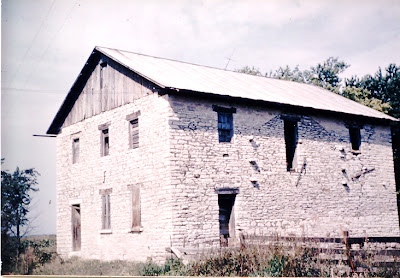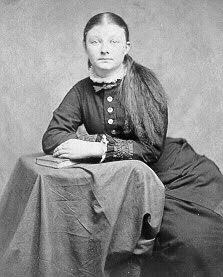He Was My Most Recent Immigrant Ancestor
Leberecht Delang (1824-1890)
He was my father’s great grandfather.
 |
| Leberecht Delang (1824-1890) Potter from Prussia, arrived 1857 |
Leberecht Delang was the last one of my ancestors to immigrate to America, arriving in New York on April 15, 1857. He brought with him his wife Beate, a daughter Marie, age 6, a son Carl, age 4, and a 4-month old baby girl, Louise. The family departed from Hamburg, Germany, aboard the ship Borussia. Leberecht, age 32, was a potter. His wife was also 32. The ship’s passenger list shows that they were passengers “between deck.”
 |
| The Steam-Ship "BORUSSIA" Regular Packet between Hamburg and New York This Currier & Ives lithograph comes from the Museum for the History of Hamburg. |
Leberecht was born 2 March 1824 in Naumburg, Schlesiem, southwest of Leipzig. Apparently the birth was registered at Leipzig, because his 1860 Intention papers for Naturalization list the place of birth as Leipzig, Prussia. In the 1930 census, his son Robert specifically records his father’s birthplace as Naumburg, Germany. Although there was another town of Naumburg located close to the Czech border in what is now south central Germany, the Leipzig area appears to be accurate.
In the 1880 census, Leberecht names the birthplace of his father as Saxony and his mother's as Prussia, and his own as Prussia. According to family legend, Leberecht's ancestors had lived on the border between France and the many small German states, in Alsace or Lorraine, and that the surname was French. A story that came down through the family traces back to around 1800, during the Napoleonic rearrangement of Europe's boundaries when border raids were common. The story is that the pregnant wife of a man named DeLong was kidnapped by German soldiers and taken to Germany. Her son was born in Saxony, and he married a Prussian woman. We do not know the name of this French child, only that his son, Leberecht DeLang, half French and half German, came to America and died in Iowa.
My grandfather explained to us that Leberecht's father, growing up in Prussia, spelled his name (DeLong) the German way (DeLang) which sounds very similar when pronounced by a German. When Leberecht came to America, the name was spelled DeLang but prounounced De Lahng.
In the 1880 census, Leberecht names the birthplace of his father as Saxony and his mother's as Prussia, and his own as Prussia. According to family legend, Leberecht's ancestors had lived on the border between France and the many small German states, in Alsace or Lorraine, and that the surname was French. A story that came down through the family traces back to around 1800, during the Napoleonic rearrangement of Europe's boundaries when border raids were common. The story is that the pregnant wife of a man named DeLong was kidnapped by German soldiers and taken to Germany. Her son was born in Saxony, and he married a Prussian woman. We do not know the name of this French child, only that his son, Leberecht DeLang, half French and half German, came to America and died in Iowa.
My grandfather explained to us that Leberecht's father, growing up in Prussia, spelled his name (DeLong) the German way (DeLang) which sounds very similar when pronounced by a German. When Leberecht came to America, the name was spelled DeLang but prounounced De Lahng.
Leberecht had been a potter since childhood. Upon arrival in America, he came on to southeast Iowa to work as a potter with Dennis Melcher, whom he had known in Prussia. The Melcher (Melchoir) brothers David and Dennis had built the Melcher Pottery near the edge of Des Moines County, Iowa, just east of the village of Lowell. It was on the road to the present-day Geode Park. The road bore the name Agency Road because it was originally the Indian Agency Road. One of the buildings still exists, and I have been by it many times. In the mid-1990s, it was converted to a restaurant with historic emphasis.
 |
| The Melcher Pottery in southeast Iowa |
 |
| Two jugs made at the Melcher Pottery, geode rocks, and Indian arrowheads. All are from the same location, near the county line between Des Moines and Henry Counties in southeast Iowa. |
Leberecht's wife Beate was in poor health for several years prior to her death in 1870. She had lost a daughter Rose back in Germany, and the infant Louise who was aboard the ship upon arrival in 1857 apparently died young. My ancestor, Robert, was born in October, 1857, just a few months after the family’s arrival in America. His brother Gustav, born in 1860, died in infancy. A sister, Pauline (Lena) was born in August of 1868; from age 1, she lived with the Goody family. At about the same time, Robert, at the age of about 12 or 13, went to live with the Gottfried Altman family, and in 1879, he married Gottfried's daughter, Pauline Elizabeth Altman.
After Beate's death in 1870, Leberecht married Tabitha Williamson, but she doesn't appear in the 1880 census. Leberecht appeared in Iowa census with a variety of spellings of his surname. He and his neighbors pronounced the name with a German twist as DAY-LONG, which led many years later to a name change spelled DeLong but still pronounced Day-long by his grandson Louis, my grandfather. Census in 1863 wrote “L. Dalong.” In 1870, it was “Earl Daylang.” In 1880, it was “Delang, L.”
Leberecht's naturalization INTENTION record reads: State of Iowa, Des Moines County: Before the undersigned, Clerk of the District Court, for said county, this day came Leberecht Delang, an alien, a free, white person, and a native of Prussia who being by me duly sworn, on his oath, declares and says: "That it is BONA FIDE his intention to become a Citizen of the United States of America, and to renounce forever, all allegiance and fidelity to any Foreign Prince, Potentate, State or Sovereignty whatever, and particularly to Frederich William 4th King of Prussia of whom he is a Subject. Sworn to and Subscribed, before me, the Clerk of said District Court, this 15th day of August 1860. [Signed both by the clerk and by Leberecht Delang.]
In early 1863 when the state census was taken, Leberecht is shown as being a "foreigner, not naturalized." In the 1870 census he is shown as a "citizen." Family records indicate that he was admitted as a citizen Oct. 9, 1863, recorded in Book B, page 467. However, I have not been able to acquire a copy of this record. My father was told that no citizenship admission papers prior to 1900 are available at the Des Moines County Clerk of the Court office. The Bureau of Immigration and Naturalization Services at Omaha, NE have no naturalization records prior to 1906. Nor did I find the record at the National Archives Branch in Kansas City. In September 2006, at the Mid-Continent Library in Independence, Missouri, I found a Naturalization Index for Des Moines County, Iowa, 1849-1857. This index was created by the Des Moines County Genealogical Society and published by the Iowa Genealogical Society in 1983. It listed DELANY, LEBRECHT, B467, County Court Records; this matches our family records.
A death record was made in Mt. Pleasant, Iowa on Feb. 27, 1890, with thedate of death given as Jan. 30, 1890 for Leberecht Delang, male, age 65, potter, widower, born in Schlesiem, Ger. He had been a resident for 30 years. The place of death was Lowell, Henry Co., IA. with burial in Lee Co., IA. [Williamson Cemetery]. Cause of death was hypertrophy of Heart and the doctor was F. R. Wilson of New London, IA.
--genieBev (genealogy Beverly)
For ideas about how to do Family History, visit:












